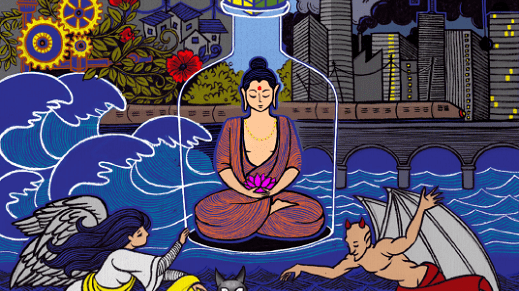Doris Lessing’s Fifth Child has been under the knife enough to not need any more dissections but speculations sometimes seem to make sense or worse no sense of the book. Fifth Child is the story of a young couple, Harriet and David who found another, just like them. They knew they meant it, and that they had to have a big family. A big family with a mansion outside town, full of guests who stayed even after the holidays and children through its halls filling everyone’s hearts with joy. The fifth child changed everything for the couple, their family cracked, the house was empty and deserted.
“It’s either him or us,” David said. Harriet had her life going the way she’d hoped even when they found it difficult to make ends meet. Harriet got pregnant too quickly and after the fourth, the doctor had advised her to rest before she planned on having another child. And then she was pregnant again with their fifth child, Ben. Harriet grew suspicious about the foetus and was sure something was wrong with it, “She imagined pathetic botched creatures, horribly real to her, the products of a Great Dane or a borzoi with a little spaniel; a lion and a dog; a great cart house and a little donkey; a tiger and a goat”.
“I don’t want to kill the nasty little brute,” Harriet said to Dr Brett after telling how Ben was suffering from a milk infection and needed something for the diarrhoea. It surprised Dr Brett that Harriet was not breastfeeding her child. She showed him her bruised nipples, and he went silent only to say, “Naughty baby” that made Harriot laugh in astonishment. Lessing offers us an alternative perspective of what if Harriot is imagining her struggles? What if Ben isn’t a troll or a goblin but just an ugly baby? Dr Brett tells her it’s not abnormal to dislike the child, and he says that he sees it too often. In the binary of a good and bad mother, Lessing lets the reader decide if Harriet is a good or bad mother. Her four children were perfect, and the house was bustling with joy and happiness till Ben was born and she gave it all up to be Ben’s mother.
David and Harriet had given Ben up to an institute where he would have been cared for and they wouldn’t have to worry. Harriet found Ben in a straitjacket locked in a room, wearing soiled clothes and any longer there, he would have died. Harriet had the choice of saving Ben or letting him die and giving her family back the normalcy they’d lost. Harriet brought Ben back and dealt with his antics and ways, trained him to get by in the real world and successfully arrive into adulthood. Harriet’s struggle with Ben took most of her time and she slowly disappeared from the lives of all her other children. All the children ended up leaving home to stay with other relatives to get some distance from Ben. David had moved out of their room the night she brought him back. Something broke in their relationship that day.
We could classify fifth Child as horror fiction, a gothic novella and a newer classification, more popular among films “Gynaecological Gothic”. An experiential account of gestation, the horror of carrying an alien or goblin or monster as a child. A dark and grim experience of violence experienced by the mother, a victim and the world’s denial to see Ben for what he truly is in Harriet’s eyes, an ugly troll that she couldn’t have birthed. The popular short story The Yellow Wallpaper by Charlotte Perkins Gilman can arguably be a Gynaecological gothic.
Lessing is the oldest recipient of the Nobel Prize for literature and Margaret Atwood in her tribute writes “If there were a Mount Rushmore of 20th-century authors, Doris Lessing would most certainly be carved upon it.” Lessing left two children behind in the care of their father, her husband in Zimbabwe and moved to London to chase her literary prospects. Harriet’s experience with Ben and bringing him back from the institute seems to lie deeper in Lessing abandoning her children but these speculations have no footing. “It was an upsetting thing to write, it goes very deep into me somewhere,” said Lessing when talking about writing the Fifth Child.
About the Author: Vinay Kumar is a a freelance photographer & writer who drinks too much coffee.



